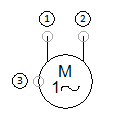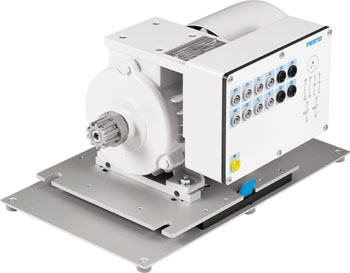Capacitor motor


The capacitor motor is a machine for converting electrical energy into mechanical energy (rotary motion). Capacitor motors are single-phase AC motors with squirrel-cage rotor. The rotary field in the stator is generated with the help of an additional capacitor, from which the name capacitor motor
originates. In order to improve starting torque, a starter capacitor is used in addition to the operating capacitor. The capacitance of the starter and operating capacitors can be adjusted, and direction of rotation can be selected. The Revolution (Switch) parameter indicates as of which speed switching from the starter capacitor to the operating capacitor takes place.
Terminal 1 and 2 are used to connect the alternating current required to operate the motor. Terminal 3 is a rotary terminal mechanism. A motor test bench or a further motor can be connected here, for example. (The direction of rotation is usually reversed via the connection. This can be selected with the connecting cable.)
The capacitor motor’s characteristic data (for example winding resistances, inductances, number of pole pairs etc.) are automatically ascertained in the background after entering the performance data. Details can be found in the following separate section: Simulation of rotating machines.
Adjustable parameters
| Designation | Range | Default value |
|---|---|---|
| Power | 0.001 ... 100 kW | 0.25 |
| Revolution | 1 ... 30000 1/min | 1400 |
| Voltage | 1 ... 10000 V | 230 |
| Frequency | 30 ... 100 Hz | 50 |
| Current | 0.01 ... 100 A | 1.86 |
| Capacity (Starting capacitor) | 0.1 ... 100 uF | 25 |
| Capacity (Running capacitor) | 0.1 ... 100 uF | 10 |
| Designation | Range | Default value |
|---|---|---|
| Direction of rotation | Right, Left | Right |
| External torque | 0 ... 100 N.m | 0 |
| Revolution (Switch) | 1 ... 100000 1/min | 1000 |